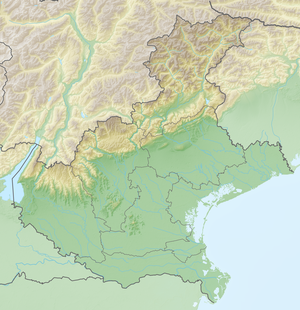Castelvecchio
| Castelvecchio | ||
|---|---|---|
|
South side on Corso Cavour with the clock tower |
||
| Alternative name (s): | Castello di San Martino in Aquaro | |
| Creation time : | 1354-1356 | |
| Castle type : | Fortress | |
| Conservation status: | preserved, museum | |
| Place: | Verona | |
| Geographical location | 45 ° 26 '23 " N , 10 ° 59' 16" E | |
| Height: | 59 m slm | |
|
|
||
Castel Vecchio was the quadrangular castle of Scaliger in Verona . The building has housed a museum since 1923.
history
Cangrande II. Della Scala had the Castelvecchio built from 1354 to 1356. A bridge ( Ponte Scaligero ) built over the Adige in 1355 secured the castle residents the escape route to the neighboring Scaliger possessions. In 1375 the tower was built over the archway and at the same time a connection to the bridge was created.
In the following centuries the building was changed several times. The Venetians used the Castel as a fortress and as a warehouse; it served as a barracks for the French and Austrian occupiers. In 1923 the state ceded the right of use to the city of Verona. From 1924 to 26 renovations took place in order to use the building as a museum. During this work, massive changes were made to the building fabric and structure. In the sense of historicism, one orientated oneself on building forms of the Renaissance; material from the remains of the palaces destroyed in the war in Verona was used.
On November 14 and 15, 1943, the first congress of the newly founded Republican Fascist Party took place in Castelvecchio , which was founded after Mussolini's fall in July 1943 and the fascist party was banned in September of the same year. At the party congress, the so-called Verona Manifesto , with which the cornerstones of the government program of the Italian Social Republic were laid down, was adopted with the cooperation of the German Plenipotentiary in Italy, Rudolf Rahn .
A few weeks after the party congress, from January 8 to 10, 1944, the so-called Verona Trial took place again in the great hall of the castle . In the show trial seven former members of the Grand Fascist Council , who in the session of 24/25 July 1943 in Rome in the Palazzo Venezia had voted for the removal of Benito Mussolini as commander in chief of the Italian armed forces , sentenced to death for high treason, including Galeazzo Ciano, Mussolini's son-in-law.
Shortly before the liberation of Verona by the Allies on the night of April 25th to 26th, 1945, the two Adige bridges Ponte Scaligero and Ponte Pietra were blown up by the Wehrmacht on April 24th . The former was rebuilt between 1949 and 1951, the latter in 1957.
Between 1958 and 1964 the museum was rebuilt by the Italian architect Carlo Scarpa .
The museum
On display are works of Veronese painting from the Gothic to the 17th century, with a special focus on the art of the Renaissance. These include works by Stefano da Verona , Pisanello , Giovanni and Francesco Caroto or Liberale da Verona . The museum also has several important works of Venetian painting, including works by Andrea Mantegna , Jacopo , Giovanni and Gentile Bellini , Carlo Crivelli , Jacopo Tintoretto , Tizian , Paolo Veronese, and Giambattista and Giandomenico Tiepolo.
Equestrian statue of Mastino II della Scala
Saint Martin (1436) - stone relief by a Tuscan master
Biblical story (middle of the 14th century) - panel by a Veronese artist
The equestrian statue of the Cangrande della Scala
The museum also houses some excellent life-size statues. The most famous is the so-called “Smiling Knight on Horseback” from the mid-14th century, Francesco della Scala, with the war name Cangrande della Scala . This two-meter-high equestrian statue originally stood on the area of the Scaliger Tombs and it was later moved here for protection after lightning hit it to the ground.
The statue shows an original cut: the horse stands still, but a long saddlecloth, as if blown back by the wind, gives the impression of lively movement. The same is true of the head of the beast and of the side view of the knight, whose large heraldic helmet hangs diagonally over his shoulder. The animal is completely covered with a finely ornamented ceiling, which proves the entire art of the Veronese stonemasons around 1330. For this equestrian monument, its original context as a tomb and the other tomb monuments, see the main article Scaliger tombs .
Art theft
On November 19, 2015, 17 paintings worth around 15 million euros were stolen from the museum. The robbers apparently knew the museum well and were extremely professional, and it is believed that they acted to order. The stolen works, including “The Quail Madonna” by Antonio Pisanello (1420), “The Holy Family with the Saint” by Andrea Mantegna (around 1500) and “The Lady of Licnidi” by Peter Paul Rubens , are not for sale.
literature
- Duby, Georges: The time of the cathedrals . Art and Society 980-1420 [1976]. Frankfurt am Main [1992] 2nd edition 1994, pp. 432-435. ISBN 3-518-28611-0
- Reclam's art guide. Italy Vol. 2. Upper Italy East. Arranged by Erich Egg, Erich Hubala u. a. Stuttgart: Reclam 1965. pp. 1083-1084.
Individual evidence
- ↑ Official museum website (English)
- ^ Italian Museo di Castelvecchio ; official website
- ↑ https://museodicastelvecchio.comune.verona.it/
- ↑ Liliana Picciotto : La macchina antiebraica della RSI e l'Ispettore generale per la razza Giovanni Preziosi. In: Michele Sarfatti (ed.): La Repubblica sociale italiana a Desenzano: Giovanni Preziosi e l'Ispettorato generale per la razza. Giuntina, Florence 2008 ISBN 978-88-8057-301-2 p. 25
- ^ Professional raid in Verona - 17 paintings stolen from the museum , n-tv.de from November 22, 2015







